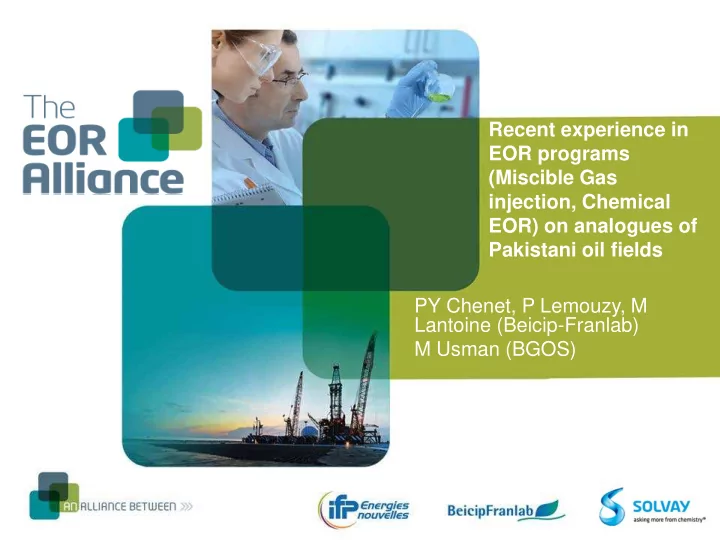

Recent experience in EOR programs (Miscible Gas injection, Chemical EOR) on analogues of Pakistani oil fields PY Chenet, P Lemouzy, M Lantoine (Beicip-Franlab) M Usman (BGOS)
Presentation Outline EOR methods as a function of oil type Principles of Miscible Gas and Chemical EOR Pakistani oil fields and their analogues EOR screening criteria Q&A 5/19/2015 The EOR Alliance 2
Enhanced Oil Recovery EOR Chemical Gas Thermal Other? CO 2 , N 2 , HC, Steam flood, Microbial, cyclic, SAGD Low Salinity foam 5/19/2015 The EOR Alliance 3
The Main EOR methods Chemical / Thermal Chemical Miscible gas 80 RF = 70% +15-30% RF % 60 +20-30% CO 2, N 2, HC Gas Alkaline / Surfactant / Polymers +20-40% 40 +5-15% 40-50% 40-50% Thermal Polymers only Water Water Injection / +10-30 % Injection Gas Injection Alkaline/Surfactant/Polymers 20 20-30% Water Injection 5-20% depletion Water Injection 1 0.1 10 100 1000 30 o 50 o + 20 o 15 o 10 o EOR share of world oil production, Oil viscosity, cP/ currently 4%, may triple by 2030 API o 5/19/2015 The EOR Alliance 4
Principles of EOR Oil Recovery efficiency: E = E m x E v E m : microscopic efficiency Volumetric sweep efficiency E v : volumetric sweep efficiency 𝐹 𝑤 = 𝐹 𝑏 × 𝐹 𝑨 25% < E < 60% Microscopic Efficiency E m S or 5/19/2015 The EOR Alliance 5
Gas Injection Water Alternating Gas (WAG) G G G Oil Bank W W W W 5/19/2015 The EOR Alliance 6
Gas Injection Water Alternating Gas (WAG) Principles Optimizes microscopic recovery (gas-oil displacement) Optimizes volumetric recovery (water-oil displacement) Advantages Management of associated gas Reduces gas mobility Sweeps zones that are not flooded by water Supposed to improve the microscopic efficiency Disadvantages Risk of rapid fluid segregation Risk of rapid gas breakthrough Decrease in water injectivity 5/19/2015 The EOR Alliance 7
Miscible Gas Injection Reservoir pressure near miscibility pressure Miscible Gas Oil Bank Zone 5/19/2015 The EOR Alliance 8
Principles of Miscible Gas Gas injection under miscible conditions Transfer C3+ from gas phase to oil phase Causes the oil to lighten and swell Through fluid expansion, enhance lighter oil recovery Requires fine PVT tuning and laboratory experiments (PVT analyses, slim tube experiments) 5/19/2015 The EOR Alliance 9
Chemical Methods Polymer Flooding Increases µ w 2-20 times Decreases M w/o 𝑁 𝑥 / 𝑝 = 𝐿 𝑠𝑥 × µ 𝑝 µ 𝑥 × 𝐿 𝑠𝑝 5/19/2015 The EOR Alliance 10
Chemical Methods Surfactant Flooding used to reduce interfacial tension between oil & water to increase microscopic recovery • Decreases S or • Increases E m 𝑭 𝒏 = 1 − 𝑇 𝑥𝑥 − 𝑇 𝑝𝑠 1 − 𝑇 𝑥𝑥 Oil droplet Rock grain Surfactant decreases residual oil saturation 5/19/2015 The EOR Alliance 11
Criteria for EOR selection Largest OOIP or Largest Remaining Reserves Recovery Factor < 60% for light oils (40+ o API) , < 30% heavy oil (< 30 o API) Additional barrel from EOR at affordable total cost (< 30 $ limit, preferably < 15$) Majority of Pakistani fields with light oil, suitable for miscible gas injection Some fields with 30 o API oil, suitable for Chemical EOR 5/19/2015 The EOR Alliance 12
Additional Criteria for EOR Selection Fluid properties • • Reservoir properties • Geological settings • Drive mechanism • Production status 5/19/2015 The EOR Alliance 13
Hassi Messaoud Miscible Gas Injection Sandstone reservoir Cambrian age Low perm (average 8 mD, a lot of oil in less than 1 mD) with high permeability features (fracture corridors or high permeability streaks) Thick and flat reservoir Light oil 45 o API, 0.4 cP MMP with associated gas : between 3200 and 3900 psia 14
Light Oil Analogue: Hassi Messaoud (Algeria) Detailed mechanistic simulations to understand gas flood 20 m 1 100 m 2 15
Light Oil Analogue: Hassi Messaoud (Algeria) Full field modeling Modified black-oil Influence of pressure in IFT (interfacial tension) Modification of Kr-Pc curves with IFT (Transition Immiscible Miscible); calibration with mechanistic simulations Dual porosity, dual permeability to represent fracture corridors Model size : 2.1 millions active cells 16
Hassi Messaoud Gas reinjection Allows to obtain: Pressure maintenance Conservation of resources (produced gas) Incremental oil production due to dynamic miscibility Improved reservoir management (additional barrel < 15 US$) The EOR Alliance 17
Chemical EOR analogues Light oil Triassic reservoir: Middle East, low K < 30 mD Surfactant polymer formulation can decrease interfacial tension Recovery in lab: > 60% of remaining oil Medium oils: Oman field cases: Polymer injection under industrial scale (RF +10% additional) 5/19/2015 The EOR Alliance 18
New Techniques: Foam for EOR Foam is a surfactant under "near gaseous " solution Foam decreases gas mobility and can decrease superficial tension Foam can combine the effect of miscible gas and chemical EOR Gas injection rates can be optimized 5/19/2015 The EOR Alliance 19
Gas Injection; WAG & Foam CO 2 miscible N 2 (combined with Fractured medium) HC gas Foam for Mobility control Foam-enhanced WAG – Water Alternating Gas higher apparent gas Continuous gas flooding (WAG) viscosity Water Water + Surfactant CO 2 Oil Oil Oil / CO 2 / CO 2 Further reduction of Viscous fingering Reduced viscous fingering viscous fingering No effect on gravity Gravity segregation Reduction of gravity segregation segregation 5/19/2015 The EOR Alliance 20
Conclusions Pakistani fields have significant potential for EOR applications Suitable EOR methods include Miscible Gas injection and Chemical (Surfactants and Polymers) Foam injection is a new alternative Further screening and prefeasibility of EOR is recommended before entering into an EOR project 5/19/2015 The EOR Alliance 21
Recommend
More recommend